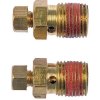So here we are stuck by the side of quite a busy suburban road with the temp way over the limit.. And along come two dirt track bikers. They stop. I stare.
"Hi Dad!"Says one,pulling off his helmet. "Why are you here?"
I don't know who is more put out. Me, because junior is not supposed to have his unlicensed bike on a main road or him,:shocked: to find me here. Busted.
"Car's overheating."I say.
"Oh."He says and rides off. So much for helpful family.
But there are compensations to being stuck with an overheating GT 40. You get a lot of attention.
"Hi Dad!"Says one,pulling off his helmet. "Why are you here?"
I don't know who is more put out. Me, because junior is not supposed to have his unlicensed bike on a main road or him,:shocked: to find me here. Busted.
"Car's overheating."I say.
"Oh."He says and rides off. So much for helpful family.
But there are compensations to being stuck with an overheating GT 40. You get a lot of attention.







